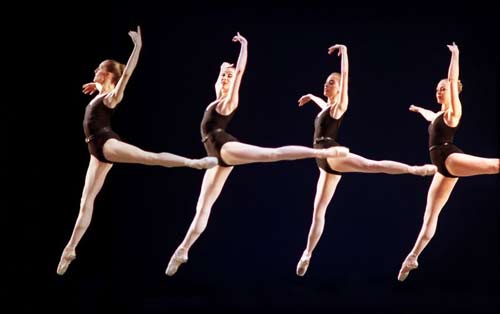New York City Ballet/George Balanchine, Coliseum, London<br/>New York City Ballet/Jerome Robbins, Coliseum, London
Over-hyped, over-priced and over here

Maybe it was jet lag. Maybe it was the trauma of the costumes getting stuck in transit. Maybe it was the stress of having to justify a £95 seat price, well above usual top whack for ballet. For whatever reason, the first night of New York City Ballet's season at the Coliseum lacked the authoritative clout we'd been led to expect from the company that virtually owns the copyright on American ballet style.
Most of these dancers weren't born when the outfit last visited London in 1983, the year that also saw the death of its founding genius, George Balanchine. And although NYCB remains unique among the world's top ballet companies for its focus on the creative output of one man, it no longer holds the monopoly on performing it. It wasn't hard to see the reasoning behind the opening programme which presented the three most iconic of Balanchine's 400-plus works. But this was to invite comparison with other London performances of the same, by the Royal Ballet, the Kirov, San Francisco Ballet and Dance Theatre of Harlem to name but a handful. Sorry, New York, but some of them do an Agon that's a darn sight sexier than yours.
Which isn't to say that the dancers from the Big Apple didn't reveal any of their USP. The company still has its own style and performing spirit – fast, attacking and upfront. Yet a few chunky girls have crept into the corps, which distorts its lines, and the men's Kirk Douglas hairdos and matching demeanour can be off-puttingly camp.
The best of the evening's dancing came in the opening item, Serenade, a piece whose first impact – of extreme feminine mystery and glamour – is eked out for the duration of Tchaikovsky's luminous score. Once you're inured to the gorgeous spectacle of 20 women in long gauze skirts that fluff up like clouds of powder as they leap, there's the craft of the choreography to marvel at. One second the stage is all flying diagonals, the next, concentric pirouetting circles, then in a blink there are just four figures, like a wreath of Grecian nymphs. Yet you never notice the joins.
The more modernist Agon was disappointing, for all the sharpness of the men's pincer-jumps, neat and natty in their iconic white T-shirts, black leggings and diddy white socks. The work's kernel, the pas de deux, whose premiere in 1957 scandalised America for presenting a black man handling a white woman, fell oddly flat, the coolly erotic potential of its power struggle sadly sold short. It felt as if veterans Albert Evans – still a fine, prowling hunk of a dancer – and Wendy Whelan – whose starved-whippet look I have never admired – had simply run their course on this number. It needs new blood.
To close the first night there was the lavish firework display that is Symphony in C, which didn't so much fizz as give the occasional splutter: Megan Fairchild and Gonzalo Garcia's third movement that took allegro vivace at its word, the final piling in of all 48 dancers, and the classical spaghetti of all those legs. What, though, was with the straggling lines in the corps? Or the guy standing at ease while his colleagues presented arms? Mr B would have fired him on the spot.
A night's sleep later, the Jerome Robbins bill was a different story. No doubt it helped, too, that two of the three works were little known and writing on a clean page. Trust Robbins – whose ability to create hit ballets for the company often rivalled Balanchine's – to find wit, as well as beauty, in a pastiche of a ballet segment in a Verdi opera. The original Four Seasons, typically, had nothing to do with the plot of the opera in which it occurred. It was merely a frothy interlude before the third act. And boy, does this one froth! What begins as a fancy-dress pageant, with the god Janus in what looks like a bedspread, gradually erupts into a fabulously virtuosic showcase. Again, in the Fall segment, Ashley Bouder's dancing was so quick and clean that it left you with a grin on your face. And if Daniel Ulbricht's bare-bummed Pan erred on the side of cute, his vertical uplift made up for it.
The orchestra had time to slope off to the pub during Moves (1959), a silent ballet whose study of soft versus hard, stroke versus hit, still looks fresh and innovative, leaving lasting images on the memory disk: a girl's heel struck against the floor like an impatient doorknocker, five boys falling on their faces like a fistful of pick-up-sticks. Who needs music when dance is this engaging?
I was going to write that, with The Concert as a closer, this show could hardly fail. That's not quite true. Suffice to say that in Robbins's madcap visualisations of a string of Chopin piano hits – the onstage audience reacting in highly personal ways (a dippy girl who hugs the Steinway, a man who longs to murder his wife) – the comedy was never over-egged.
Season continues to 22 March (0871 472 0600)
Subscribe to Independent Premium to bookmark this article
Want to bookmark your favourite articles and stories to read or reference later? Start your Independent Premium subscription today.

Join our commenting forum
Join thought-provoking conversations, follow other Independent readers and see their replies